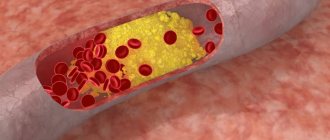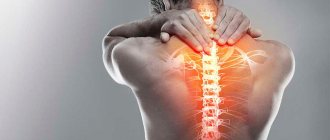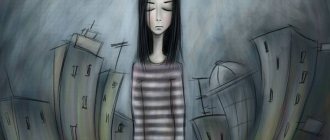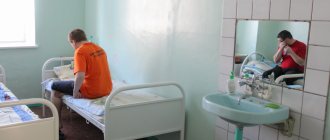VSD (vegetative-vascular dystonia) is a syndrome that occurs when the function of the autonomic nervous system is impaired.
Neurologists at the Yusupov Hospital are identifying the cause of autonomic dysfunction using modern research methods. To treat patients, drugs are used that relieve or reduce the symptoms of VST, psychotherapeutic methods and innovative methods of rehabilitation therapy. Due to the variety of symptoms of VSD, gastroenterologists, endocrinologists, cardiologists and other related specialists are involved in the treatment of patients. Severe cases of VSD that cannot be treated are discussed at a meeting of the Expert Council, in which professors and doctors of the highest category take part.
Causes of VSD
Doctors diagnose VSD if the following symptoms are present:
- weakness, loss of ability to work;
- sensations of goosebumps all over the body;
- heartbeat;
- body aches;
- trembling hands.
Vegetative-vascular dystonia can develop in the presence of constitutional characteristics of the body or burdened heredity. The autonomic nervous system can be exposed to traumatic factors during fetal development or childbirth. In most cases, vegetative-vascular dystonia syndrome is a manifestation of a disease of internal organs and dysfunction of the endocrine glands.
The occurrence or exacerbation of VSD is provoked by the following factors:
- changes in weather conditions;
- physical or mental fatigue;
- stress;
- unbalanced diet;
- wrong lifestyle;
- imbalance of hormones during puberty or menopause;
- sleep quality disturbances.
Body pain, numbness of the left or right arm, weakness in the legs with VSD occur after emotional stress. Patients “break” their arms and legs, their hands tremble, and body aches appear even after minor stress. A vegetative crisis can cause both negative and positive emotions.
How are headaches, spots in the eyes, and osteochondrosis related?
Osteochondrosis affects the cartilage tissue in the part of the spine in which it occurs. The discs between the vertebrae are more often affected - they withstand greater loads. When cartilage is deformed, nerves and blood vessels are pinched, which ultimately leads to side symptoms. If a patient is diagnosed with osteochondrosis in the cervical region, vision problems may be a consequence of this particular disease. They manifest themselves in the form of dysfunction of the visual organs, the appearance of spots in the eyes, and increased pressure in the eye area. How do changes in the spine lead to eye dysfunction? Let's figure it out.
The relationship between the underlying disease and secondary symptoms
When deformed, the disc loses strength, shape and elasticity (stretches), and a hernia appears. The spaces between the vertebrae decrease, and the spinal column becomes curved. The canal in which the spinal cord, arteries, and veins are located also bends. As a result of its bending, the contents are compressed.
The vessels of the circulatory system are responsible for the blood supply to the brain. In the absence of proper nutrition, ischemia occurs. As a result:
- Headache;
- Dizziness;
- Extraneous noise in the ears;
- Discomfort in the organs of vision.
Symptoms
Painful sensations appear due to impaired venous outflow. Where blood stagnates, the walls of blood vessels become thinner. As a result, plasma components change location and enter the interstitial space. Swelling and pain appear. Nerves are compressed and ischemia worsens. The lesion occurs on the left or right side, respectively, the functioning of the left or right eye is disrupted.
With some diseases, patients experience floaters and flare-ups. Such phenomena as tinnitus, nausea, and dizziness are also not uncommon. There are many reasons, one of them is neck osteochondrosis.
Front sights
This symptom manifests itself when the patient moves parts of the body and turns his head. In these cases, blood flow is reduced. Sufficient pressure is important for all components of the visual organ, especially the retina. If blood does not flow to distant areas through small vessels, a deficiency of oxygen and nutrients occurs.
The retina, which is responsible for the perception of light impulses and transformation into nerve messages, suffers. The latter, in turn, enter the brain through channels. He perceives them and analyzes them. When there are not enough nutrients and oxygen, the cell does not convert light impulses, the area remains “dark” - these are flies.
Lightning
This no less popular symptom appears due to deformation of the vitreous body. Let's imagine the eyeball - it has a transparent structure, reminiscent of jelly. This mixture includes proteins, water, salt, hyaluronic acid, elastic fibers, collagen. This mixture of ingredients provides a spherical shape. The eyeball can stretch forward and return to its previous position.
Since the internal contents are colorless, light passes through freely. There are not even vessels through which blood moves in the structure. Everything that is needed to nourish the cells comes through the walls. If nearby vessels are compressed, swelling occurs. There is more collagen, its fibers become thicker. The result is light flashes or circles.
Ghosting
Double image in diseases of the spine is a common symptom. Its appearance is caused by compression of blood vessels. Diplopia indicates that the blood circulation in the brain is impaired; negative consequences in the form of a stroke may soon appear.
To avoid this, you need to consult an ophthalmologist.
The earlier the better. Checking the field, visual acuity, pressure, diagnosing changes in the fundus - all this can reveal osteochondrosis of the cervical spine. After this, the doctor will prescribe treatment to eliminate the symptoms of the disease. Author: K.M.N., Academician of the Russian Academy of Medical Sciences M.A. Bobyr
Symptoms of VSD
With vegetative-vascular dystonia, the following signs of autonomic dysfunction occur:
- panic attacks;
- increase or decrease in blood pressure;
- heart rhythm disturbances;
- chills or sweating;
- increase in body temperature to 37.3°C;
- weakness in arms and legs;
- body aches.
Patients report that their hands are trembling, they constantly have “goosebumps all over their bodies,” and their arms and legs are “burning.” Twitching of the muscles of the face, upper and lower extremities, headache, nausea and vomiting, and pale skin occurs. Fainting often occurs, and patients continue to feel anxious. Often, darkening of the eyes and severe weakness with VSD occur with a sudden change in body position. When experiencing symptoms of VSD, a person begins to become afraid of them. This further enhances vegetative manifestations. A vicious circle is formed from which it is no longer possible for the patient to get out on his own. A person who has experienced a panic attack experiences fatigue, emptiness, lethargy, and drowsiness. In this case, psychotherapists from the Yusupov Hospital work with the patient.
What causes the pathological condition?
Many factors provoke the phenomenon. They can be divided into dangerous and non-hazardous, for which there is no need for therapy. Mandatory treatment is required when numbness and muscle weakness of the limbs are caused by the following reasons:
- diabetes;
- severe disturbances in the functioning of the cardiovascular system;
- anemia;
- intervertebral hernia;
- sciatica;
- hormonal changes in the body;
- pathologies of the thyroid gland;
- chronic stress;
- chronic fatigue;
- cervical radiculitis;
- cervical spondylosis;
- multiple sclerosis;
- neuralgia;
- severe poisoning with chemical compounds;
- oncological diseases;
- frostbite of the extremities;
- necrotizing vasculitis;
- cervical osteochondrosis;
- heart attack;
- consequences of stroke;
- muscle protein deficiency;
- Raynaud's disease;
- lack of vitamin B12;
- tunnel syndromes,
- migraines – numbness and weakness occur during a headache attack;
- tumor diseases of the brain.
Causes of numbness and weakness of the limbs that are not dangerous and do not require treatment, which go away on their own in a short time, include:
- keeping a limb in one position for a long time causes a temporary circulatory disorder;
- staying in tight clothes for a long time;
- prolonged very strong physical activity;
- starting gymnastics classes - in this case, due to micro-strains of muscles and ligaments, in addition to numbness and weakness, pain is also added, which persists for 2-4 days;
- hypothermia (not to be confused with frostbite).
If the patient cannot accurately determine how dangerous the factors that led to the development of the pathological condition are, he should definitely consult a doctor. Depending on the cause of the problem, it can be treated by a neurologist, orthopedist, surgeon, neurologist, endocrinologist or therapist.
Diagnosis of vegetative-vascular dystonia
Body aches, weakness in the arms and legs, and a crawling sensation can be symptoms of many diseases. Neurologists at the Yusupov Hospital conduct a comprehensive examination of patients with signs of VSD. Instrumental studies are carried out using the latest equipment from leading global manufacturers. For laboratory research, high-quality reagents are used to obtain accurate test results.
The cause of pain in the body, crawling sensations, numbness of the limbs, trembling of the hands may not be VSD, but organic lesions of the brain. At the Yusupov Hospital they are excluded or confirmed using magnetic resonance imaging. When performing an MRI of the brain using special modes, doctors see changes in the brain tissue itself.
If a patient with VSD has blood pressure that rises infrequently, these changes are reversible. With persistently high blood pressure, dyscirculatory encephalopathy develops. More often, such changes occur in areas of the brain with initially reduced blood flow. In the process of diagnosing the causes of VSD, a clear analysis of the cerebral vessels is necessary. Such a study is carried out at the Yusupov Hospital using the latest generation MRI machines using special MRI programs. They make it possible to determine the state of cerebral vessels without administering contrast. Timely assessment of the state of the brain is important for the prevention of hypertensive crises, since hypertensive VSD can result in a cerebral stroke.
An important addition to MRI studies for VSD is ultrasound of the vessels of the brain and neck. It shows the function of blood vessels in dynamics, allows you to navigate those parts of the VSD that are disturbed, clarify the cause of autonomic dysfunction and make a decision on the choice of treatment tactics. Ultrasound examinations at the Yusupov Hospital are carried out using expert-class equipment. In order to identify vascular disorders of the brain and VSD in particular, doctors analyze the venous component of cerebral blood flow. For this purpose, unique diagnostic developments are used, which make it possible to determine with a high degree of reliability the nature and cause of VSD using computer and ultrasound analysis of slow and fast cerebral venous blood flow.
1.What are weakness and fatigue?
Fatigue and weakness are terms that are often used interchangeably to describe how you feel. But in fact, weakness and fatigue are slightly different things, and it is important to know exactly what you feel when you say “I feel weak” or “I am tired,” because an accurate description of your condition will help the doctor correctly determine the cause of deterioration in health.
So what do weakness and fatigue mean?
- Weakness
refers to a lack of physical, or muscular, strength and a feeling that extra effort is required to move the arms, legs, or control other muscles. If muscle weakness is caused by pain, the person will be able to perform the required activity, but it will hurt. - Fatigue
is a feeling of tiredness, exhaustion, or needing rest due to lack of energy or strength. Fatigue can be the result of overwork, poor sleep, anxiety, boredom or lack of physical activity. Fatigue can be a symptom of illness or a consequence of taking medications and certain treatments, such as chemotherapy. Anxiety and depression are other possible causes of fatigue.
Both weakness and fatigue are not diseases, but symptoms of some problems. Because weakness and fatigue can occur for a variety of reasons, it is important to evaluate other signs of health problems to properly diagnose and manage the problem.
A must read! Help with treatment and hospitalization!
Treatment and prevention of VSD
Neurologists at the Yusupov Hospital begin treatment of VSD with symptomatic therapy. If vegetative-vascular dystonia manifests itself as a decrease or increase in blood pressure, it is stabilized. As part of the treatment of VSD, pharmacological drugs of several groups are used:
- peripheral vasodilators and antispasmodics;
- calcium ion antagonists;
- calcium channel activators;
- centrally acting angiotensive drugs;
- sympatholytics;
- drugs affecting the angiotensin system
- diuretics.
- psychotropic drugs.
More fine regulation of vascular tone in the treatment of VSD is carried out with the help of drugs that affect the sympathetic part of the nervous system - sympatholytics or sympathomimetics. Ganglion blockers act on the adrenal medulla, simultaneously affecting an important anatomical link in the central regulation of stress reactions.
Treatment of VSD with diencephalic crises is a different level of impact. It involves effects on the brain. For this purpose, doctors at the Yusupov Hospital prescribe vegetotropic drugs to patients suffering from vegetative-vascular dystonia. Their point of application is the sympathetic or parasympathetic part of the nervous system. Drugs act through the cortex and some associated subcortical structures of the brain. Reflexive methods of influence that are used by rehabilitation specialists at the Yusupov Hospital have a sedative effect:
- acupuncture;
- metameric receptor effects;
- craniotherapy (cerebral and scalpel acupuncture);
- RANC therapy (impact on the cause leading to the appearance of symptoms of VSD).
Prevention of VSD is of no small importance, especially if it is accompanied by trembling of the hands, numbness of the arms and legs, and weakness in the limbs. Rehabilitators use effective methods of physiotherapy, various types of massages and proprietary methods of influencing the autonomic nervous system. A senior exercise therapy instructor-methodologist individually selects a set of therapeutic and breathing exercises that helps prevent vegetative crises. Psychotherapists, using innovative techniques, teach patients to cope with stress and calmly deal with the manifestations of VSD. You can undergo a course of VSJ therapy by calling the Yusupov Hospital.









